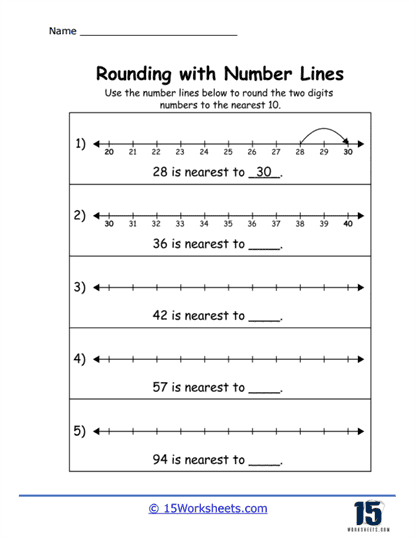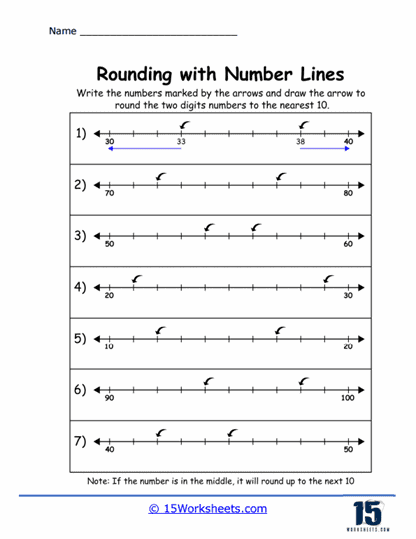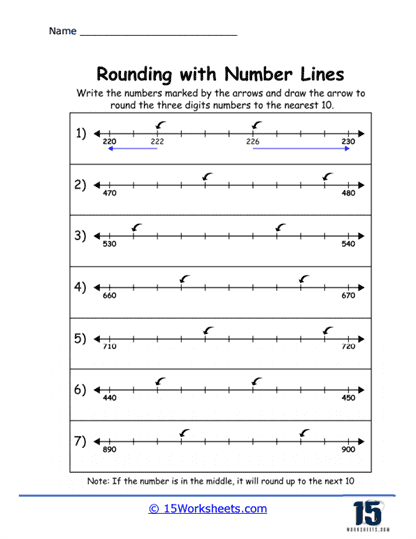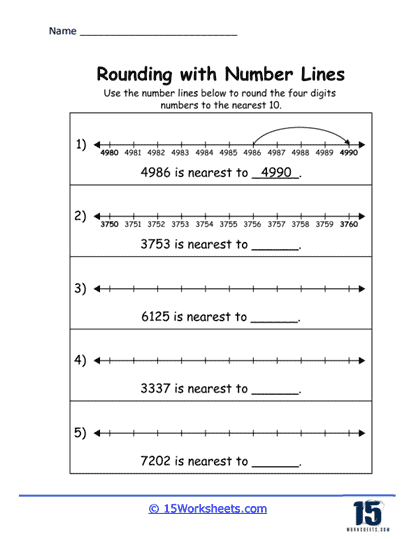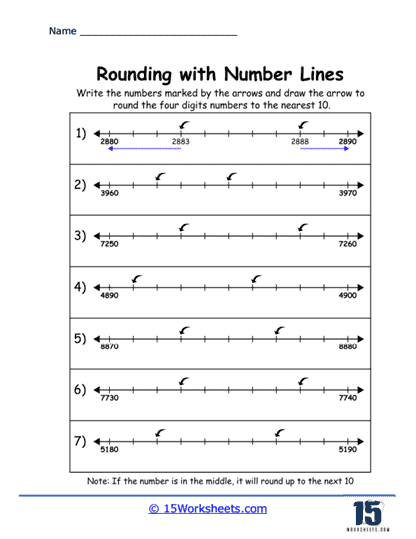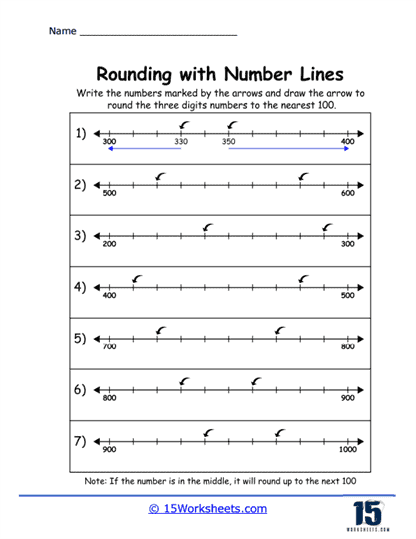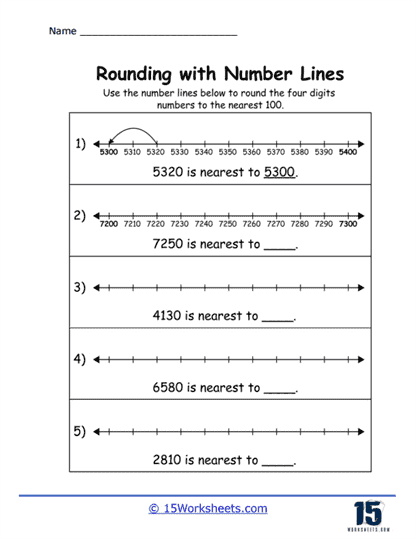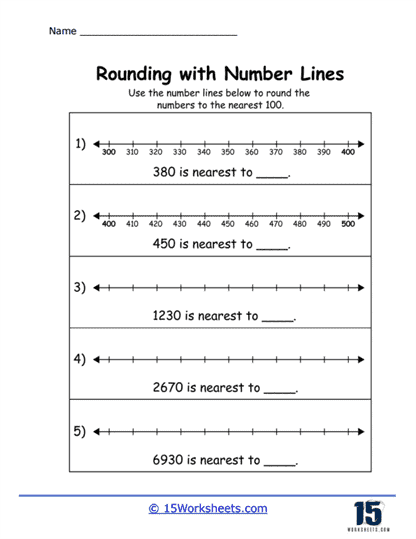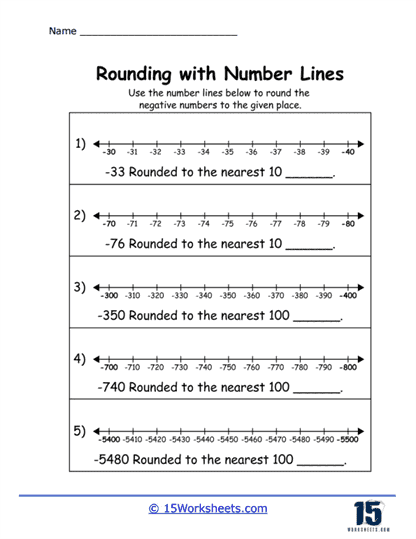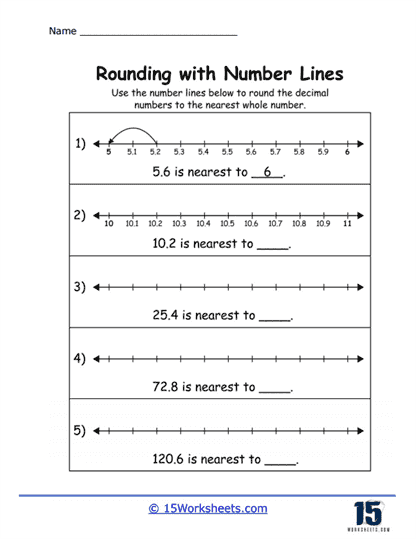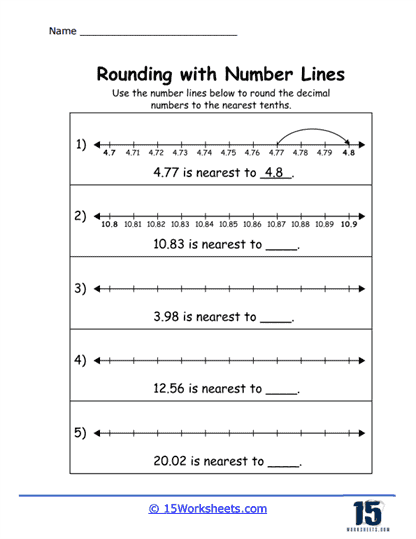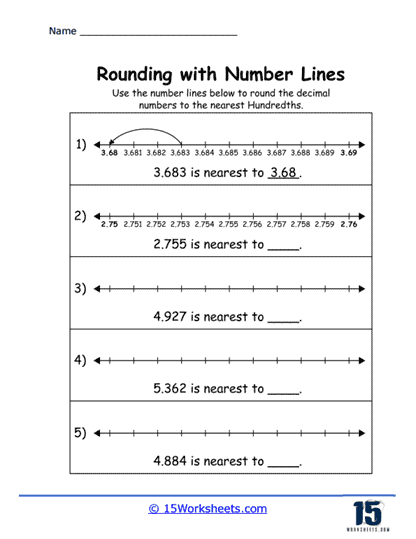Round Using Number Lines Worksheets
About These 15 Worksheets
These worksheets offer students a visual and hands-on approach to understanding the concept of rounding numbers. These worksheets guide students through the process of rounding various types of numbers-whole numbers, decimals, and multi-digit numbers-using number lines as a tool. Each worksheet typically contains a set of number lines marked with intervals, and students must use these lines to round numbers to the nearest ten, hundred, thousand, or even tenth or hundredth. This method offers a clear visual representation of where numbers fall on a number line, helping students determine whether they should round up or down. The practice emphasizes the importance of place value and gives students an intuitive understanding of rounding rules in different contexts.
On these worksheets, you’ll often find simple number lines with marked intervals, sometimes going up by tens, hundreds, or smaller increments like tenths or hundredths. The number lines are used to show where a particular number lies in relation to the nearest intervals. For example, if a number is closer to 30 than 20 on a number line, the student is expected to round it up to 30. This kind of visual cue helps reinforce the rounding rule: round up when the number is halfway or more, and round down if it’s less than halfway. This rule applies to all numbers, whether rounding to the nearest ten, hundred, or tenth. In this way, students gain a solid understanding of rounding through repeated visual and interactive practice.
The first type of skill these worksheets teach is rounding to the nearest ten using number lines. Students are asked to locate numbers on a number line that might go from, say, 20 to 30. By seeing where the number falls, students decide whether it’s closer to the higher or lower ten. This process helps reinforce their understanding of numbers and place values, which are essential building blocks in mathematics. Students are essentially practicing estimation, learning to simplify numbers in a way that makes math more manageable. When they can easily round numbers up or down, they will find future calculations involving larger numbers less intimidating.
Another important math skill covered in these worksheets is rounding larger numbers, like hundreds or even thousands. Here, the number lines are stretched to accommodate larger intervals, for example from 5300 to 5400 or 7000 to 8000. Students must evaluate whether the given number should be rounded up or down based on its proximity to these larger multiples of ten, hundred, or thousand. This practice not only strengthens their estimation abilities but also deepens their understanding of how large numbers are structured. It’s also an important step in preparing students for more advanced math concepts, such as working with larger datasets, solving problems in geometry, and dealing with real-world scenarios where they need to simplify or approximate large figures.
Decimals are also a focus in these worksheets, and students practice rounding decimal numbers to the nearest tenth or hundredth using number lines divided into smaller increments. This is where students begin to see the connection between whole numbers and decimals in a new way. For example, a number like 4.77 might be rounded to the nearest tenth by using a number line divided from 4.7 to 4.8. Seeing decimals on a number line helps students visualize that even though decimals are small, they follow the same rounding rules as whole numbers. By mastering decimal rounding, students improve their skills for working with money, measurements, and scientific data, where precise yet rounded figures are often necessary.
In addition to working with decimals and whole numbers, these worksheets often require students to round multi-digit numbers to the nearest hundred or thousand. This can include tasks like rounding numbers such as 2784 to the nearest hundred. The visual nature of the number line helps students clearly see whether the number should be rounded up or down. For example, a number like 2784 is closer to 2800 than it is to 2700, so it gets rounded up. This approach teaches students the importance of analyzing the digits and their positions carefully before making a rounding decision.
For students who struggle with the abstract nature of rounding, number lines provide a concrete way to grasp the concept. By physically seeing where a number lies between two others, the decision to round up or down becomes easier. This visual aid reinforces their learning in a way that traditional rounding techniques may not. It also adds an element of interaction, as students are encouraged to draw or mark their answers on the number lines provided. This tactile aspect of rounding with number lines engages different learning styles and makes the process of rounding more enjoyable and easier to remember.
This set of worksheets introduce students to the many facets of rounding numbers, from simple whole numbers to more complex decimals and multi-digit numbers. Each type of rounding problem on these worksheets-whether it’s rounding to the nearest ten, hundred, thousand, tenth, or hundredth-helps students develop their mathematical reasoning and estimation skills. The use of number lines as a visual tool makes the abstract concept of rounding much more tangible, and gives students a step-by-step process for making rounding decisions. Mastering these skills is important for future mathematical success, and these worksheets provide a solid foundation for rounding in real-world applications, such as money, measurements, and statistics.
Rounding numbers is a fundamental math skill that students will use throughout their education and daily life. Whether it’s simplifying calculations, making estimations in real-world situations, or solving more advanced problems, the ability to round numbers quickly and accurately is essential. By using these worksheets, students gain a deeper understanding of rounding and place value, while also developing their confidence in approaching math problems that involve large numbers or precise decimal calculations. The clear, visual structure of number lines makes learning to round easier and more intuitive, allowing students to progress to more complex math topics with a strong foundation in place.
Whether students are rounding to the nearest ten, hundred, thousand, or dealing with decimals, these worksheets help build a solid understanding of place value and rounding rules. The visual aid of number lines helps students internalize the concept of rounding in a more intuitive way, making it easier for them to apply these skills in both mathematical and everyday contexts. This method of learning not only strengthens students’ math skills but also enhances their ability to think critically about numbers and how they can be simplified for easier calculations.

